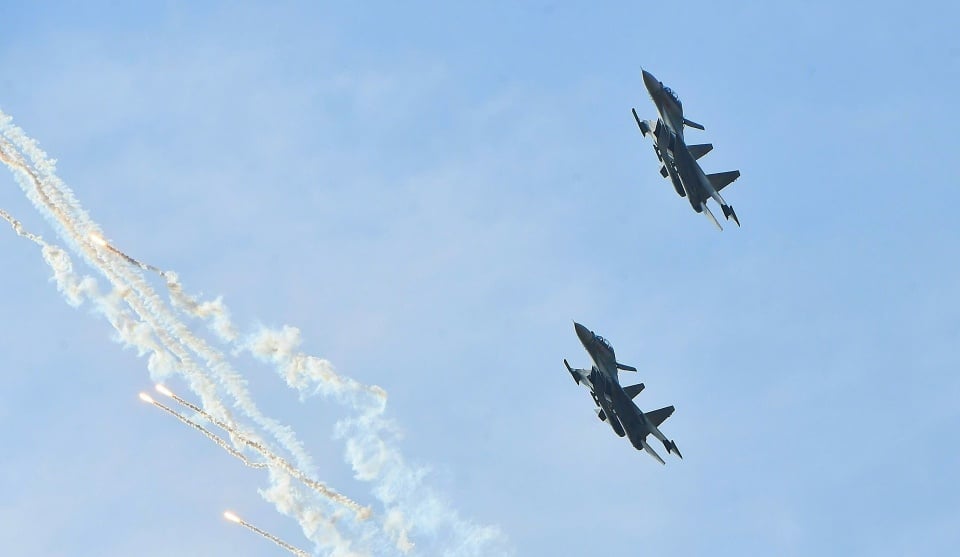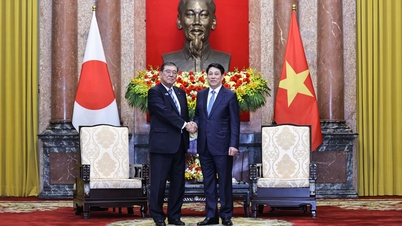 |
Su-30MK2 fighter jets drop heat traps in the sky of Ho Chi Minh City. Photo: Hoang Ha . |
In modern combat, fighters like the Russian Air Force's Su-30 face many threats, especially from heat-seeking missiles such as MANPADS (man-portable air defense systems) or air-to-air missiles... To protect aircraft from these threats, flares technology plays an important role in the Su-30 fighter's defense system.
What is a heat trap?
Heat traps, also known as false heat targets (ЛТЦ - ложные тепловые цели in Russian), are pyrotechnic devices designed to generate large amounts of heat when ignited. The structure of a heat trap is quite simple: a small canister containing solid fuel, similar to signal or illumination ammunition. When launched, the heat trap creates a heat source stronger than the aircraft engine, fooling the missile's infrared seeker, causing the missile to divert to the heat trap instead of aiming at the aircraft.
On the Su-30 fighter, heat traps are fitted with automated dispensers, commonly known as jammers. These devices are integrated with the aircraft's defense system, allowing heat traps to be launched manually by the pilot or automatically in some cases, depending on the threat.
The role of heat traps on Su-30 fighters
The Su-30, including variants such as the Su-30SM, is one of the main platforms of the Russian Air Force, widely used in operations in Syria and Ukraine. With the ability to operate in both air-to-air and air-to-ground environments, the Su-30 is constantly facing threats from heat-seeking missiles. Heat traps are an integral part of the aircraft's defense system, helping to protect the pilot and aircraft from attacks.
According to Western sources, such as the article on The Drive, the Su-30SM has been used creatively in the role of a tactical "heat trap". During a visit to the Hmeimim base in Syria by Russian President Vladimir Putin, Su-30SM fighters accompanied his Tu-214PU aircraft at maximum power, creating hotter exhaust to attract potential MANPADS missiles. At the same time, the Su-30SM deployed a large number of heat traps, creating fake heat targets in space, increasing the ability to deceive enemy missiles.
Limitations and challenges
While heat traps are an effective technology, the Su-30SM’s defense system does have some limitations. According to The Aviationist, many Russian aircraft, including the Su-30SM, are not equipped with advanced missile approach warning systems. This means that the launch of heat traps often depends on the pilot’s observation and reaction, rather than being fully automated. In complex combat environments, this can reduce the effectiveness of heat traps.
In addition, modern heat-seeking missiles, such as the American AIM-9X or the Russian Igla-S, are improved with the ability to distinguish between heat traps and aircraft engines. This requires the Russian Air Force to constantly upgrade heat trap technology, such as using more advanced heat traps (e.g. PPI-26 IW) or combining them with directional infrared countermeasures (DIRCM) systems such as the Vitebsk L370, although this system is currently mainly equipped on aircraft such as the Su-25SM3.
Practical application
Heat traps have proven their worth in real-life operations for the Su-30. In Syria, the Su-30SM regularly flew strike and patrol missions, where they were at risk from low-altitude rebel air defenses. The release of heat traps, combined with evasive maneuvers by the pilots, helped reduce the risk of being shot down by heat-seeking missiles. Similarly, during the conflict in Ukraine, Russian aircraft such as the Su-30 and Su-34 were recorded using heat traps to counter MANPADS deployed by the enemy.
Images and videos from sources such as the EurAsian Times show the Su-30SM launching heat traps, creating bright streaks of light in the sky.
The future of heat-trapping technology on the Su-30
As missile technology continues to advance, the Russian Air Force is looking to improve the Su-30’s defenses. One potential avenue is to integrate DIRCM systems such as the Vitebsk L370, which uses lasers to disrupt the missile’s infrared seeker. However, heat traps will remain an indispensable part of the Su-30’s defensive arsenal, thanks to their low cost, effectiveness, and rapid deployment.
Additionally, Russia may develop new types of heat traps that emit more complex heat signatures to deceive advanced generations of missiles. Combining heat traps with innovative tactics, such as using the Su-30 as a “fake heat target” during escort missions, will also continue to be exploited.
The heat trap technology on the Russian Air Force’s Su-30 fighter jet is a prime example of the balance between efficiency and cost in modern warfare. While not a perfect solution, heat traps have played an important role in protecting the Su-30 from threats from heat-seeking missiles. As military technology continues to evolve, heat traps will continue to be improved and combined with advanced defense systems, ensuring that the Su-30 remains one of the most formidable fighters in the sky.
Source: https://znews.vn/cong-nghe-bay-nhiet-tren-su-30-con-ac-mong-cua-ten-lua-tam-nhiet-post1550013.html




![[Photo] The parade took to the streets, walking among the arms of tens of thousands of people.](https://vphoto.vietnam.vn/thumb/1200x675/vietnam/resource/IMAGE/2025/4/30/180ec64521094c87bdb5a983ff1a30a4)


![[Photo] Cultural, sports and media bloc at the 50th Anniversary of Southern Liberation and National Reunification Day](https://vphoto.vietnam.vn/thumb/1200x675/vietnam/resource/IMAGE/2025/4/30/8a22f876e8d24890be2ae3d88c9b201c)
















![[Photo] Chinese, Lao, and Cambodian troops participate in the parade to celebrate the 50th anniversary of the Liberation of the South and National Reunification Day](https://vphoto.vietnam.vn/thumb/1200x675/vietnam/resource/IMAGE/2025/4/30/30d2204b414549cfb5dc784544a72dee)






































































Comment (0)